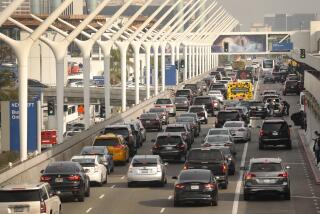More people are flying but TSA lines at LAX are shorter. How did this happen?
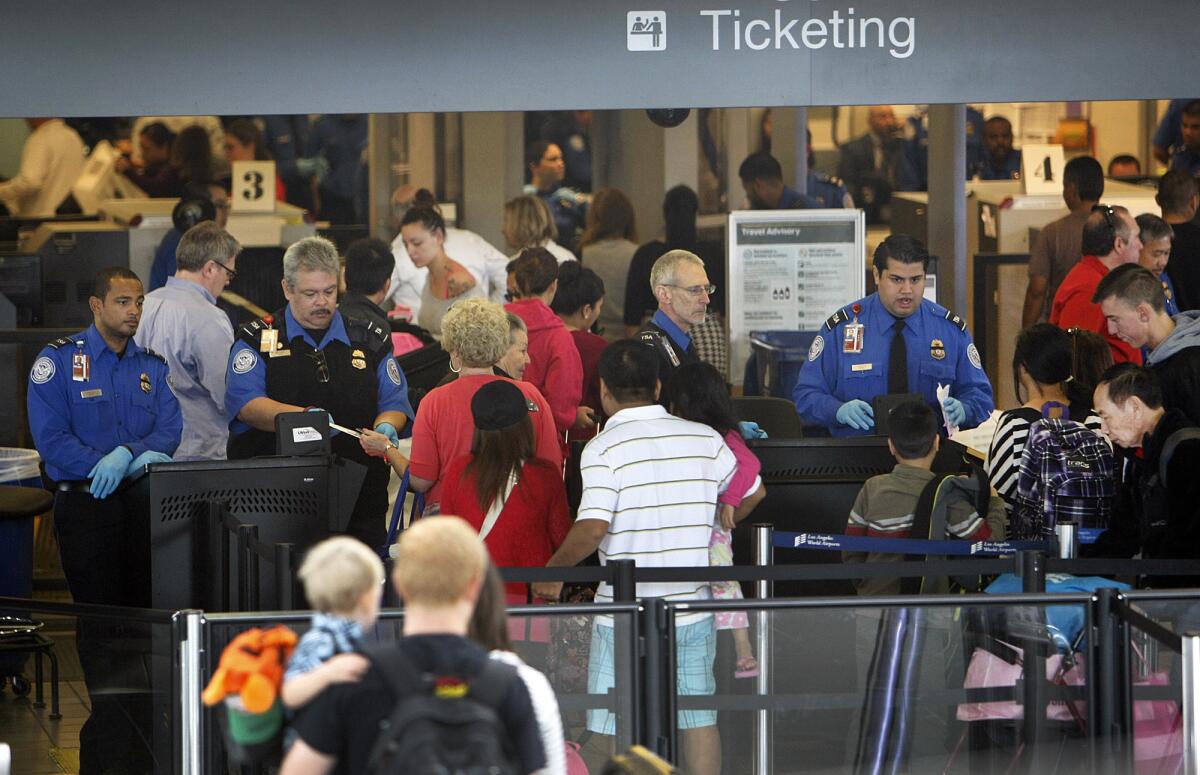
- Share via
Summer 2016 found airline passengers across the country fuming about airport security checkpoint lines that stretched for up to two hours.
The outrage was so widespread that the Twitter hashtag #Ihatethewait started trending. A few federal lawmakers demanded the resignation of the Transportation Security Administration chief, who apologized for the summer of waiting.
Since then, the number of passengers flying out of U.S. airports has increased 15%, but average wait times have barely inched higher, TSA data show.
And at most of the 30 largest airports, including Los Angeles International, average wait times have fallen significantly, according to three years of TSA data analyzed by The Times. At some of those major airports, average wait times have fallen as much as 66%, with LAX achieving a decline of about 40%, The Times’ analysis of more than 20,000 data points found.
But California’s other big airports haven’t been able to decrease average wait times since 2016, TSA data show. At San Francisco International, wait times rose considerably, while the screening queues at San Diego International grew slightly.
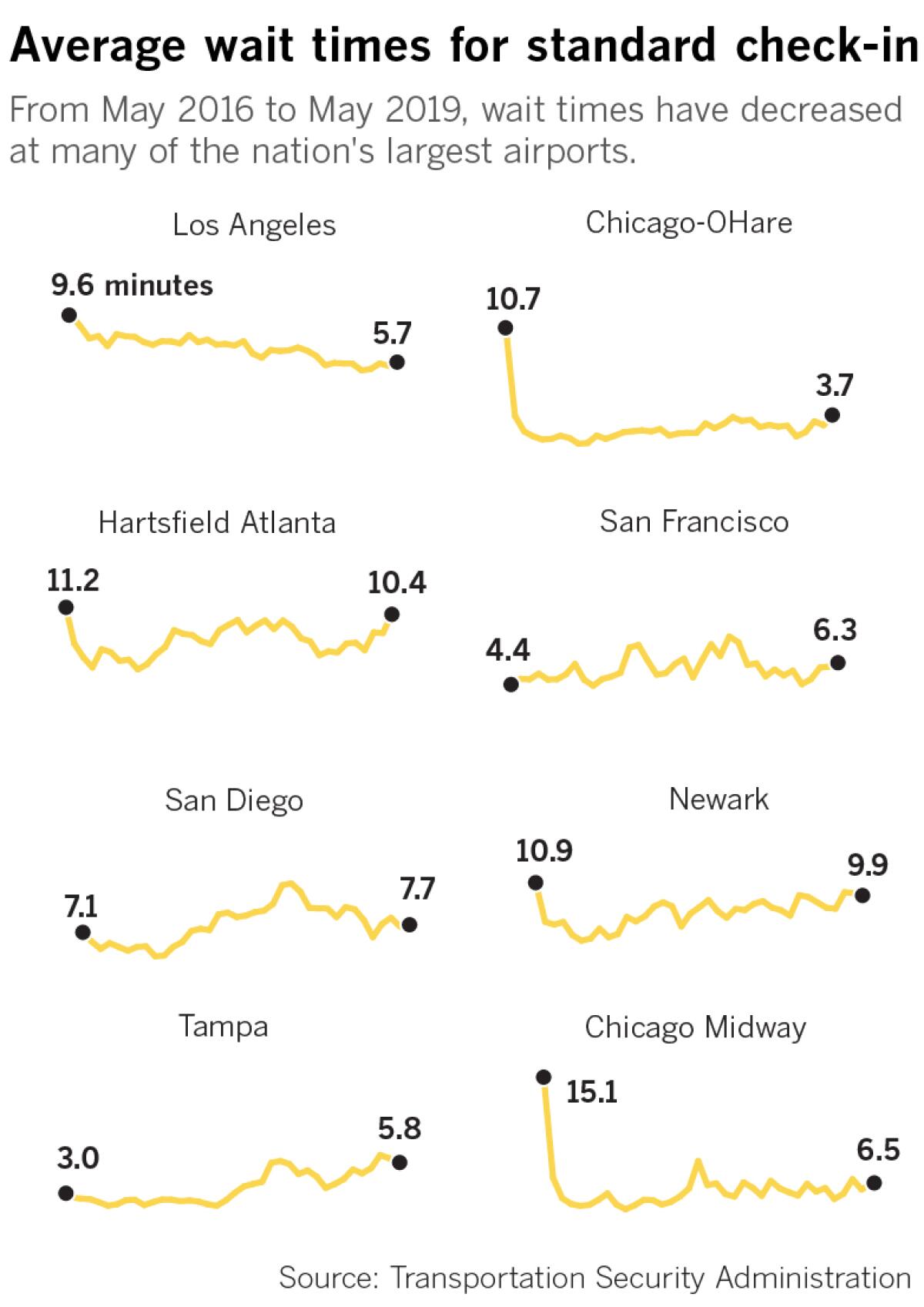
Keeping airport wait times from increasing — even in the face of record air travel numbers — has been a big worry for the TSA, airports and airlines, all of which benefit from keeping American travelers happy.
They’ve been able to pull this off by spending big on staffing, advanced screening technology and new facilities, pushing the TSA PreCheck expedited screening program as well as improving communications and cooperation.
L.A.’s notoriously jammed roadways may have even played a role in reducing the amount of time that travelers wait for security screening at LAX.
Passenger rights groups and veteran fliers have given the TSA and industry players credit for keeping wait times in check.
“They seem to be adopting the kind of staffing policies that fast-food restaurants use, which is to bring in more people on peak times,” said Paul Hudson, president of Flyers Rights, a nonprofit passenger advocacy group with more than 60,000 members. “I think they’ve finally improved.”
Richard and Gail Grenier of Yorba Linda recently flew out of LAX to Paris and noticed the TSA lines were a few minutes shorter than in the past.
“It wasn’t bad at all,” Richard Grenier said.
Karen Corcoran, a retiree from Huntington Beach who regularly flies out of LAX to vacation in the U.S. and abroad, said she has also noticed an improvement at TSA checkpoints. “I think it has gotten a little better over the years,” she said.
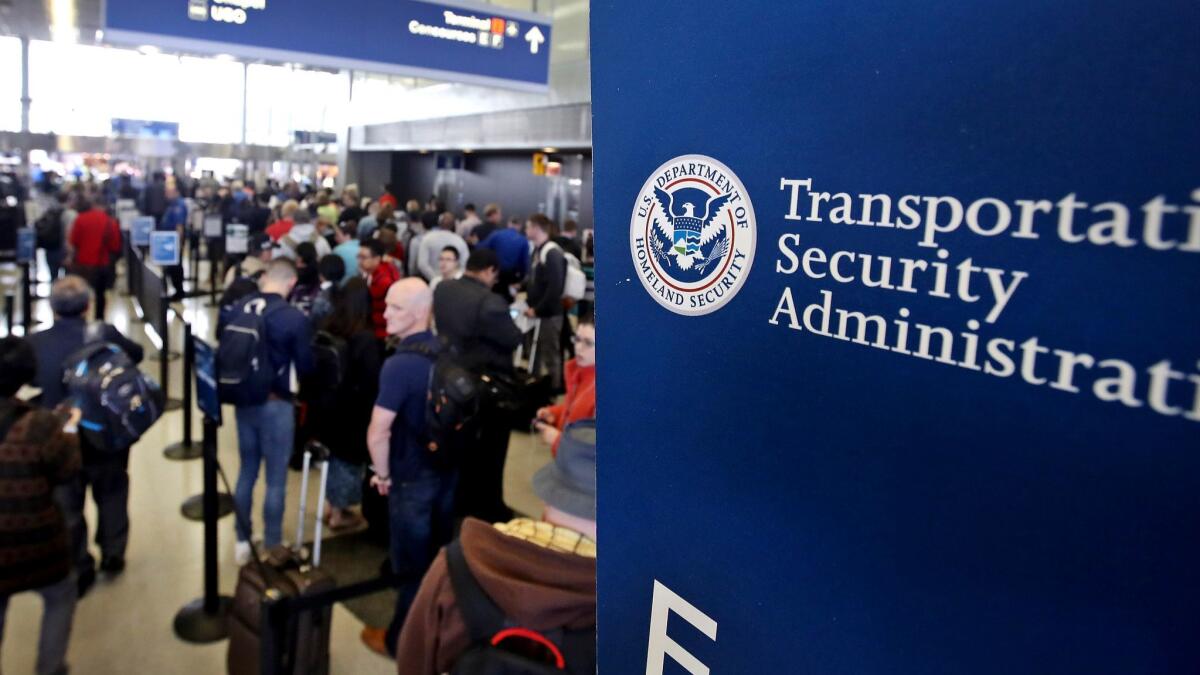
Among the findings from the analysis of TSA data from May 2016 to May 2019 were:
- The average wait time at LAX dropped by nearly four minutes, to just under six minutes, at standard TSA checkpoints and fell by nearly one minute, to less than 90 seconds, in TSA PreCheck lines. The number of fliers screened at the airport rose 11.5% over the last three years. (LAX screens more passengers than any other U.S. airport even though Hartsfield-Jackson Atlanta serves the most travelers overall; many of the flights at the Atlanta airport are connectors whose passengers were screened at another airport.)
- The average wait time at Chicago O’Hare International Airport dropped by seven minutes, to under four minutes, in standard TSA lines and dropped to 90 seconds in TSA PreCheck lines. The lower wait times came despite a 10% increase in the number of passengers screened.
- At San Francisco International, the average wait time rose nearly two minutes, to nearly 6½ minutes, in standard screening lanes, while the number of passengers screened at the airport rose 8.5%. San Francisco International is among more than 20 U.S. airports that rely on a private security firm to screen passengers. Through a TSA spokeswoman, the firm said the wait expansion is “negligible” considering the increase in passengers.
- The average wait time at standard screening lanes at San Diego International Airport rose about half a minute, to just less than eight minutes, while the average wait time at TSA PreCheck rose by nearly a minute, to just over two minutes. San Diego International recorded a 22% jump in passenger screenings, one of the biggest among the nation’s busiest airports. The airport has launched a $3-billion expansion plan that will help the facility serve the 33 million passengers it is expected to serve by 2030.
Americans began to fly in huge numbers as the U.S. economy improved from the financial meltdown in 2008 and 2009, and lower fuel prices helped keep airfares relatively inexpensive. The number of passengers screened at U.S. airports jumped 15% to 72.3 million in May, compared with the same month in 2016, according to TSA data.
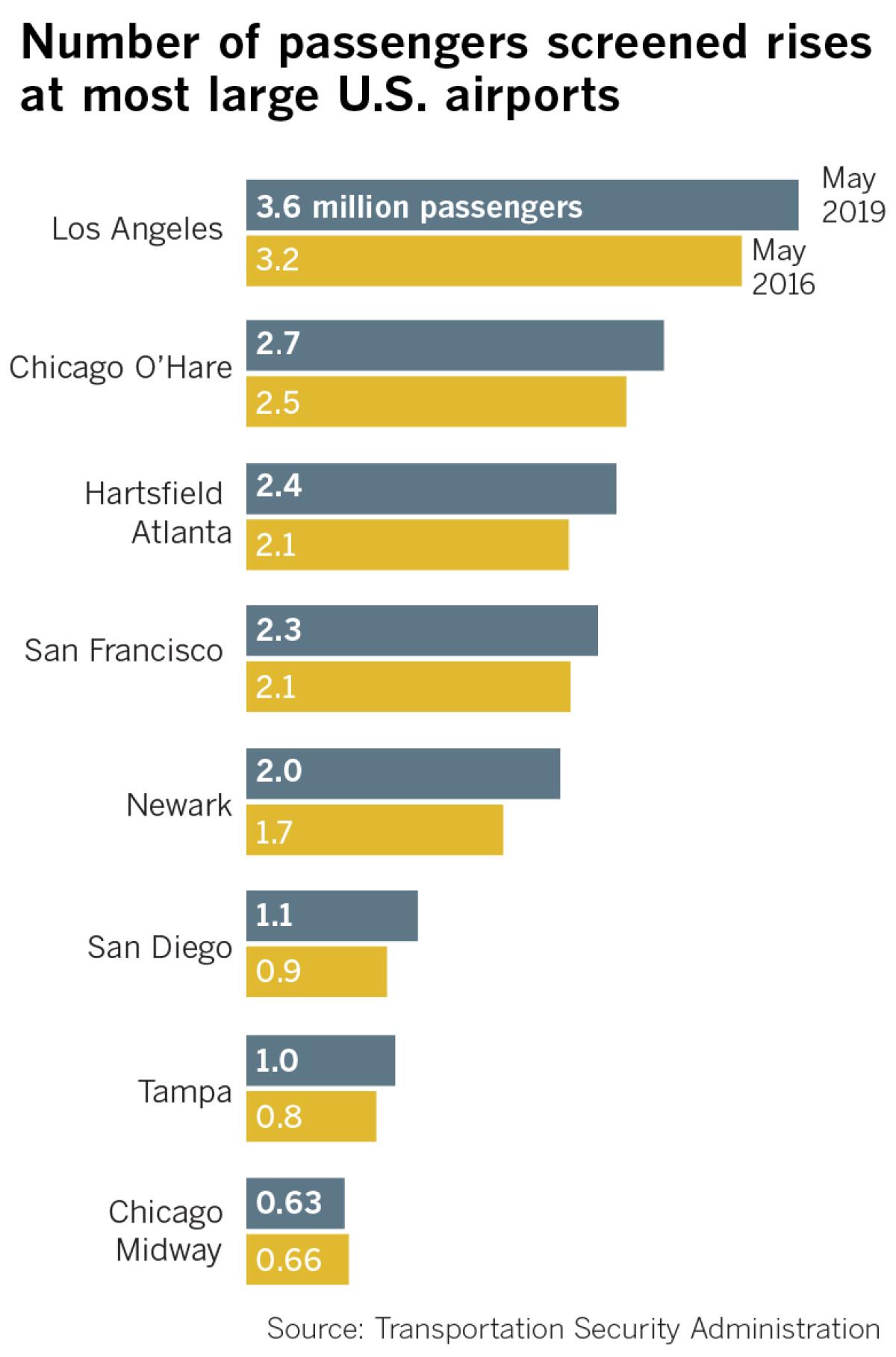
But wait times over the last three years didn’t keep pace with the passenger increase throughout the country.
Instead, average wait times rose by less than half a minute at all 444 airports in the country. Even peak wait times dropped at the 30 largest airports to less than 17 minutes, from an average of about 21 minutes, according to TSA data.
A combination of factors has kept wait times in check at most of the nation’s busiest airports, aviation experts say.
One thing that likely helped keep wait times from surging has been a 10% increase in TSA screeners hired since 2016, bringing the total to more than 45,500 full-time officers.
In addition, more fliers have signed up to use the expedited TSA PreCheck lines. Nearly 9 million fliers have paid $85 apiece to use TSA PreCheck lines at more than 200 airports across the country. There were 2.7 million members in 2016.
Since summer 2016, TSA leaders said, they have learned to share information with airports and airlines about daily travel trends so that the TSA will be ready with extra screeners during peak demand times.
“Having that information up front is really, really important,” said Darby LaJoye, TSA’s executive assistant administrator for the office of security operations.
In fact, the federal Government Accountability Office praised the TSA in a report released last year, saying the agency has shared information with airlines and airport operators to ensure that surges in passenger traffic don’t result in prolonged wait times.
The nation’s biggest airlines, which have a financial stake in keeping wait times from discouraging more Americans from flying, have also helped reduce those times by investing in expanding airport terminals and buying new screening equipment at some of the nation’s busiest airports.
At LAX, for example, Delta, United and American have paid to install a total of 30 new automated screening lanes that use multiple conveyor belts to allow up to five passengers to simultaneously unload bags, shoes and clothes into bins to be screened. Airline officials say the lanes can make screenings up to 30% faster. The lanes cost just under $900,000 each.
Such lanes are being used in airports across the country, but LAX has the greatest number of automated screening lanes in the nation.
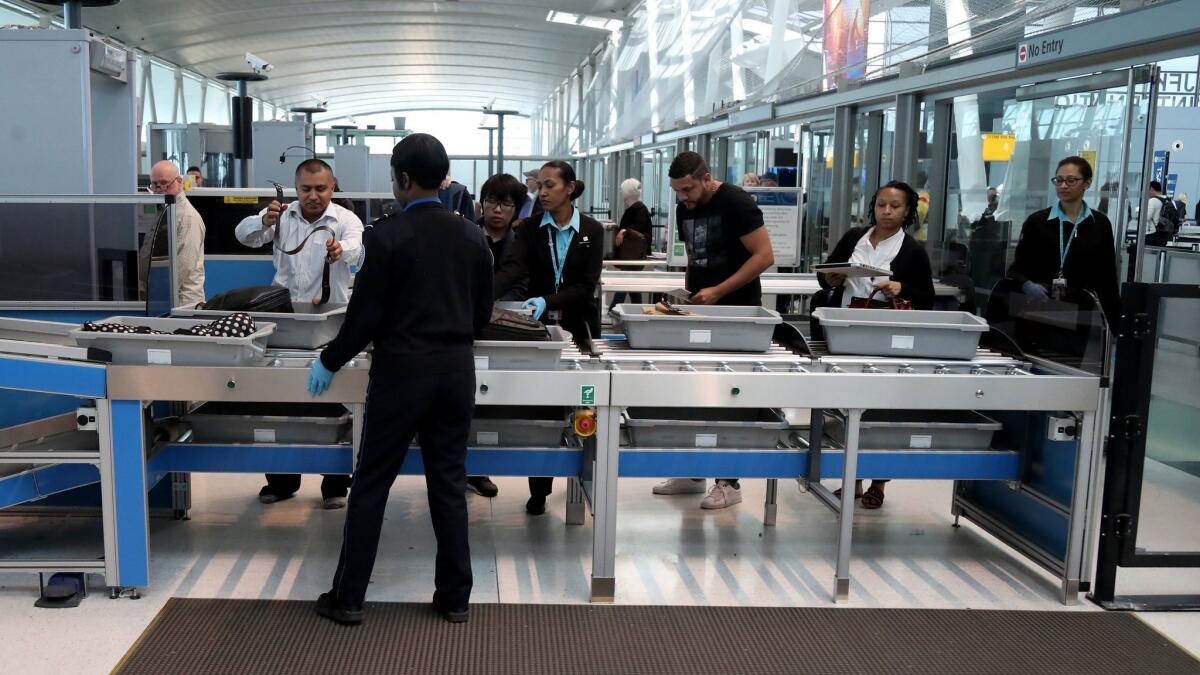
Delta and American have each launched terminal expansion projects at LAX, with price tags of more than $1 billion each.
“Airlines today have a vested interest in getting the passenger through quickly,” said John Pistole, a former TSA administrator who now is president of Anderson University in Indiana.
Keith Jeffries, LAX’s federal security director, points to the addition of the 30 automated screening lanes and increased cooperation with airline and airport officials as primary reasons why wait times at LAX have been kept in check despite the rise in air passengers.
“It’s everyone working together, communicating on a regular basis,” he said.
One of the factors that is most frustrating about flying out of LAX — vehicular traffic — may also be helping to keep checkpoint wait times down, Jeffries said. LAX fliers know that traffic is often heavy and unpredictable, so they arrive at the airport extra early, which helps to flatten the spikes in passengers at the TSA checkpoints.
“It meters itself,” he said. “It’s a gift and a curse.”
At Chicago O’Hare International, where the average wait time has dropped more than 60% over the last three years, the Chicago Department of Aviation opened a two-lane checkpoint at the international terminal in June to cut wait times and has begun using video analytics to monitor and respond to crowding in the terminals.
“It’s all about ensuring the right amount of people are on duty at the right time,” said Robert Spinden, O’Hare’s assistant federal security director. The department also recently added nine automated screening lanes throughout the airport, he said.
O’Hare’s neighboring airport, Chicago Midway International, had a big drop in wait times, but the main reason had to do with a 4% decline in passengers since 2016. It has been the only one among the nation’s 30 biggest airports to record a decline in passengers over the last three years.
TSA officials say the drop in air passengers at Chicago Midway has mostly been the result of the airport’s biggest carrier, Southwest Airlines, having trouble adding routes with its newest plane, the Boeing 737 Max. The latest model of the 737 has been grounded since March following two deadly crashes in Indonesia and Ethiopia. Southwest Airlines had to park 34 of the jets and postpone deliveries of 41 other aircraft.
As a result, the average wait times at the standard TSA checkpoints at Midway International dropped by 8½ minutes, to a total average wait time of 6½ minutes, and dropped by a minute, to just under two minutes, for the TSA PreCheck lines.
At the airports where wait times have increased since summer 2016, many have lacked terminal space to add TSA checkpoints to absorb boosts in international and domestic travelers, TSA’s LaJoye said.
“The problem with capacity constraints is that you have no ability to add machines or add people,” he said.
The biggest rise in average wait times over the last three years took place at Florida’s Tampa International and Orlando International airports, and San Francisco International, according to the analysis.
At Tampa International, the average wait time jumped from just under three minutes in May 2016 to nearly six minutes in May 2019. At the same time, the number of passengers using the airport rose nearly 15% to more than 959,000 fliers in May.
Tampa International representatives said the airport is undergoing an expansion as part of a $2-billion overhaul that is designed to accommodate up to 34 million passengers a year.
“We are seeing record passenger numbers at Tampa International and our screening times are still lower than the national average at large hub airports,” Tampa International spokeswoman Janet Scherberger said.
In San Francisco, the international airport recently opened the doors to its new $2.5-billion Harvey Milk Terminal 1. The facility, which is still being built out, is expected to add several new gates to serve the airport’s growing demand.
The average wait times at Orlando International rose slightly more than two minutes in May, to a wait time of nearly seven minutes, in the standard checkpoint lanes, compared with the same month in 2016, according to TSA data. That may be attributed to a jump in passenger traffic, especially international fliers. In May, Orlando International recorded the seventh consecutive month of double-digit increases in international traffic, with domestic arrivals and departures jumping 7% in that month.
“The TSA in Orlando is working with substantially fewer lanes due to space restrictions than at other airports with similar passenger volumes,” said TSA spokeswoman Sari Koshetz. “And yet we have impressive wait times demonstrating that the TSA Orlando team is clearly motivated, efficient and effective while screening and keeping travelers safe every day.”
More to Read
Inside the business of entertainment
The Wide Shot brings you news, analysis and insights on everything from streaming wars to production — and what it all means for the future.
You may occasionally receive promotional content from the Los Angeles Times.


